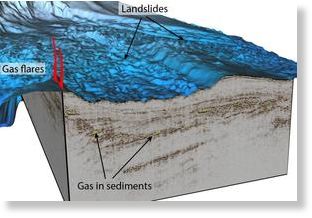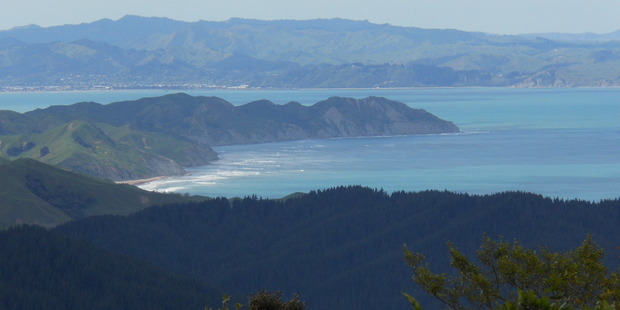The finding comes as the 11-member expedition ends tomorrow morning with the NIWA deepwater research vessel Tangaroa arriving back in Wellington.
The team, led by marine geologist Dr Joshu Mountjoy, had been investigating the area after German and Kiwi researchers last year revealed 99 seabed gas flares there using state-of-the-art 3D and 2D seismic and echosounder technology.
Following this discovery, Dr Mountjoy and his team sought to find out whether methane was getting through the water column to the ocean's surface and into the atmosphere, and determine what contribution it was making to global greenhouse gas.
The first objective of the voyage was to remap gas flares in the area in fine detail, using a range of acoustic techniques.
Surprisingly, the team discovered that every area of carbonate rock and every fault seen on the seafloor was expelling gas, and in total, they calculated there were near to 766 individual gas flares within the area.
"That was really way beyond expectations," Dr Mountjoy told the Herald tonight.
"Flares can occur in these kind of environments but seeing them in that kind of density is highly unusual - and we've certainly found nothing like it in New Zealand before."

"We have recorded video footage showing columns of bubbles streaming out of the sea bed," Dr Mountjoy said.
"Preliminary indications are that methane is reaching the ocean surface - this is the first time this has been measured in New Zealand," he said.
"However, to understand how much methane, and then what this means for atmospheric contributions, will require detailed analysis of the data."
The biological survey of the gas flares zone had secured a major advance for science, he said, with observations suggesting that chemoautophic species - those that depend for food on a symbiosis with bacteria that use the methane - can occur at relatively shallow depths.
Dr Rowden said this meant the scientific understanding of the life that inhabited the area of these gas seeps needed to be re-evaluated, and a new model formulated.
The researchers now had a "massive dataset" to analyse, Dr Mountjoy said, and he believed the discovery warranted a wider investigation along the length of the Hikurangi margin, extending off the east coast of the North Island.
Some of the gas seeps discovered off Poverty Bay last year had been observed venting from the seabed in flares up to 250m high.
The discovery of this high concentration of gas flares in shallow water depths - 100m-300m - on an active tectonic subduction zone was unique, as gas seeps usually ocurred much deeper, at 600m to 1000m below the surface.
The team identified methane gas in the sediment and in the ocean, and vast areas of methane hydrates - ice-like frozen methane - below the seafloor.
This year's research voyage continued the work of an international project focusing on the interactions between gas hydrates and slow-moving landslides called SCHLIP - Submarine Clathrate Hydrate Landslide Imaging Project.




Is the fact that these flares and the tonns and tonns of methane gas they spew out have not discernable effect on our climate...
Hey, that's what the IPCC have been saying for years now!! Who am I to question authority?